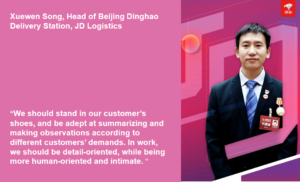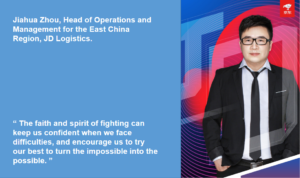by Rachel Liu and Tracy Yang
On March 26th, JD.com recognized and celebrated outstanding talent for 2019. Ten talents were selected through internal nomination or recommendation, with a selection lasted for over a month and the final result obtained by company-wide anonymous vote.
JD’s Outstanding Talent in 2019 share some common attributes. They foremost reflect the corporate values of JD.com and serve as leading examples to their colleagues. JD’s corporate values are Customer First, Integrity, Collaboration, Gratitude, All in, and Ownership.
How they reflect these values can be seen in how they support the corporate strategy, collaborating across functions to achieve larger goals. Other ways include how they constantly seek innovative breakthroughs, maintaining a spirit of resilience and hard work in challenging circumstances to achieve superior results, etc.
The outstanding talents are as following:
Carol Fung, Vice President of JD. com, Outstanding Contributor
Carol Fung, also President of FMCG (Fast Moving Consumer Goods) Omnichannel, is a superb leader. In 2019, she not only led the FMCG team to achieve record-breaking sales, but also created innovative retail models such as omnichannel integration. She is a leader who is continuously pushing new horizons and the navigator of her team.

Clark Meng, Director of Collaboration, 7FRESH, Outstanding Contributor
Meng has 20 years of experience in offline retail, and after 4 and a half years at JD, he has led his team to use technology and supply chain to empower lower tier markets, creating an example for omnichannel retail.

Arthur Ao, Head of Industry IoT, JD Cloud and AI, Outstanding Contributor
JD’s technology development is made possible thanks to its phenomenal team of tech experts. Arthur Ao has helped JD’s smart home devices platform to surpass RMB 10 million. In the past year, he also led JD’s partnership with State Grid Corporation across 27 provinces in China.

Xuewen Song, Head of Beijing Dinghao Delivery Station, JD Logistics, Customer First
Xuewen Song is the true embodiment of the value of customer first. In the 7+ years he has been with JD, Song has delivered over 220,000 orders, traveling over 330,000 km, without making a single error or receiving a single complaint from customers.

Jian Zhao, JD Courier, Integrity
When Jian Zhao found that a customer had left money in clothes intended for donation, he didn’t hesitate to return the money to the customer, even though the roads were blocked by heavy snow. Thank you Jian for demonstrating the integrity of JD employees!

Zuoyi Zhang, Head of Blockchain Product Innovation, JD Digits, Collaboration
Zuoyi Zhang is one of JD’s earliest-joining blockchain product managers. By collaborating with different teams, he successfully promoted the launch of several blockchain products. He embodies JD’s value of collaboration in everything he does and has brought tremendous value to his team and the company.

Meng Ding, International Business Development, JD Property, Gratitude
Having worked at JD for more than 10 years, Meng Ding has witnessed the company’s development arc, and when internationalization became key to JD’s strategy, he offered to go abroad to develop the business. His constant spirit of gratitude (another of JD’s values) to his colleagues and clients has carried him through numerous challenges.

Jiahua Zhou, Head of Operations and Management for the East China Region, JD Logistics. All In.
When Jiahua Zhou became the head of JD Logistics’ operations team a year ago, he faced multiple challenges and a heavy work load. In three months, he successfully streamlined processes and built a strong foundation for achieve his team’s annual targets. The spirit of “all in” is fundamental to his success.

Wenxin Kuang, Head of Online Operations, 7FRESH. All In.
Wenxin Kuang joined JD 8 years ago and has grown from a sales assistant to a team head. She has created many innovative marketing tools and successfully explored omnichannel solutions in multiple offline businesses. Her spirit of “all in” has led her journey in omnichannel retail.

Danghui Wang, Customer Service Manager, JD.com.
Danghui Wang joined JD in 2004. He is not only a core team member, but also a model of JD’s company culture. As a customer service manager, every June 18 and Single’s Day promotion, he and his team members would work overnight to get the job done. His spirit of ownership is the key to his success.

(liuchang61@jd.com; tracy.yang@jd.com )






















